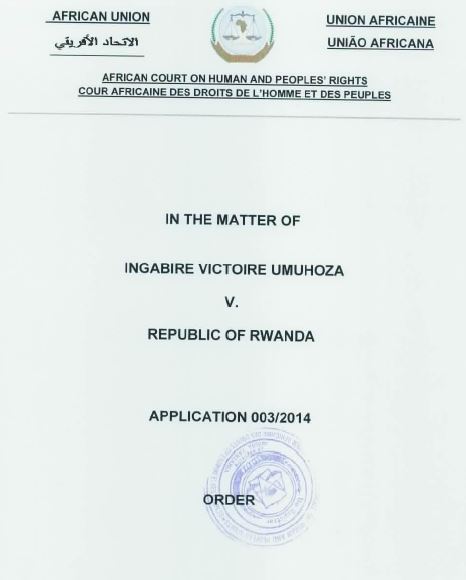The Network of African National Human Rights Institutions (NANHRI) has conducted some really interesting research into the relationship between African National Human Rights Institutes (NHRIs) and the African Court that has culminated in the report “What Do National Human Rights Institutions Know about the African Court on Human and Peoples’ Rights?”. The report makes for fascinating, if somewhat bleak reading. In order to dig a little deeper, I held a Q&A session with NANHRI’s Lenser Anyango to discuss the report’s methods, its findings and the future relationship between African NHRIs and the African Court. My thanks go to the NANHRI’s Lenser Anyango and Daniel Amollo for their time and assistance.
OW: First of all, what prompted the NANHRI to undertake this research?
Lenser Anyango (LA): Informed by conclusions from a meeting that NANHRI held early in the year dubbed “The Role of NHRIs in monitoring the implementation of decisions of African Human Rights Bodies”, NANHRI saw the urgent need to analyze the current challenges to the implementation of the African Court’s decisions at the national level and the potential role that NHRIs can play. Emanating from the meeting was the fact that once a decision has been made by the Court and the implementation process begins, it is not clear what mechanisms are put in place to effectuate these decisions especially at the national level. Therefore NANHRI envisioned that this study would assist in determining if in deed there are processes and structures of implementation of the African Court’s decisions at the national level.
OW: The NANHRI sent questionnaires to NHRIs in the seven countries that have deposited the Special Declaration allowing citizens and NGOs with observer status direct access to the African Court (Burkina Faso, Cote d’Ivoire, Ghana, Malawi, Mali, Rwanda and Tanzania). Why only these seven?
LA: Owing to the financial and time constraints encountered while implementing the study, NANHRI sought to use the best criteria in designing the study. Thus, out of the 29 states which have so far ratified the African Court’s Protocol, NANHRI narrowed its representative sample to the seven member states who have deposited the Special Declaration. The criterion was deemed appropriate as through these seven states, NANHRI felt it would gather extensive information given the fact that they enjoy more privileges in accessing the African Court.
OW: Does the NANHRI plan to canvas the views of NHRIs where the Special Declaration has not been deposited?
LA: With a diverse membership of 44 NHRI members in Africa, NANHRI intends to work with all its members in the region.
OW: The report seems to find a contradiction between the African Court’s narrative and NHRI’s narrative on the relationship between them. Is it fair to say that the African Court is painting a far more positive picture of the relationship compared to the NHRIs themselves? If so, why is this?
LA: From various responses received from the NHRIs, the work of the African Court has remained alien to most of the NHRIs. The African Court has made few attempts to reach out to them, which shows why the Court and its activities are not yet connected to the work of the NHRIs. In effect, the NHRIs and their work are quite disconnected and detached from the work of the African Court.
Also, the NHRIs are not seeing any synergy between their work and that of the African Court. This is critical because understanding the relationship between NHRIs work and the African Court’s work is necessary to underline their complementarity and establish where their synergy lies at the national level.
OW: The report finds that only a few NHRIs are even aware that someone from their country has submitted an application to the African Court directly or indirectly. Did your research get any sense of why this is? How can NHRIs help applicants bringing cases before the African Court?
LA: The study’s findings show that most of the NHRIs are quite detached, disinterested and disconnected from the African Court process. This should be a serious concern considering that both the African Court and the NHRIs are central pillars of human rights protection and promotion on the continent.
Some NHRIs feel that the application process is too complex, while others feel it is rather simple, though the majority confirm that they are yet to familiarize themselves with the African Court’s rules of procedure. Well, from the foregoing, it is not clear if it is the lack of familiarity with the rules of the Court which is militating against their general mandate to monitor these cases and support these victims or lack of interest since no attempt has been made to do so.
Some of the NHRIs are of the opinion that the domestic courts can play a role in enforcing decisions of the African Court. However, some NHRIs actually maintain that there is no such role for domestic courts. This difference in opinion amongst the NHRIs is a critical challenge towards their actual or potential role in monitoring and supporting the enforcement of African Court decisions at the national level.
Also, some of the NHRIs interpret their mandates narrowly and see no nexus between their work and that of the African Court. They do not see any role that they can play to follow up on the implementation of the African Court’s decisions. In fact, some are of the opinion that it would be an interference to be enjoined to the work of the African Court as the Court is an independent body.
OW: At the domestic level, the report finds that only Cote d’Ivoire’s NHRI confirmed having been involved in the domestic advocacy processes that led to Cote d’Ivoire’s ratification of the African Court Protocol and the depositing of the Special Declaration. How does the NANHRI envisage NHRIs working in countries where either the African Court Protocol or the Special Declaration have yet to be signed?
LA: Currently, NHRIs are weak partners with the African Court when it comes to monitoring the implementation of its decisions at the national level. However, all NHRIs’ core protection and promotion mandates are quite suitable for their engagement with the African Court and its processes, which the NHRIs have yet to exploit. The African Court cannot achieve its objective without the involvement of NHRIs together with other national stakeholders.
Consequently, NANHRI, in implementing its mandate to encourage the establishment of NHRIs in conformity with the Paris Principles, plans to work with NHRIs to:
1. Take up a leading role to encourage ratification of international human rights instruments and ensure their implementation in line with the Paris Principles.
2. Participate in the State reporting processes
3. Cooperate more with regional human rights mechanisms. This is an area which needs further strengthening by fostering active engagement between the institutions.
OW: One of the most prominent findings in the report is that most NHRIs did not know the African Court’s processes for submission of applications or the African Court’s rules of procedure. I think everyone would agree that information is essential. Given that there are some resources out there such as The Monitor’s Essential Guide, and the African Court website, how can this situation be improved? Is it as simple as sending NHRIs a basic fact sheet such as the Monitor’s to at least begin the process?
LA: Having information and making use of it are two different things. As already mentioned, the study findings show that most NHRIs are quite detached, disinterested and disconnected with the African Court process. Thus bringing them on board requires various strategies to be used for effectiveness. NANHRI envisions that the fact sheet can be used as an eye opener for the NHRIs and hopefully try and see how best they can assume their role so as to address this glaring gap between the two institutions.
OW: Prominently, the report also found that the NHRIs stated that they have never received requests from individuals or NGOs for assistance to access the African Court. Did your research get an idea as to why this was? Is it a lack of understanding among citizens or NHRIs not connecting issues they come across with potential applications at the African Court?
LA: The above observation can be attributed to a number of reasons including the lack of capacity and the context in which the NHRIs operate. Most of the NHRIs do display a critical lack of interest and knowledge on the operations of the African Court and its activities and specifically the decisions made by the African Court. Most of the NHRIs interviewed do not yet consider monitoring the implementation of the African Court decisions as part of their mandate.
This last observation is significant since it highlights the question of the NHRIs relevance and legitimacy pertinent to the Paris Principles. Though from our findings, it is not clear if it is the lack of familiarity with the rules of the African Court which is militating against their general mandate to monitor these cases and support these victims or lack of interest since no attempt has been made to do so.
OW: As we begin to see the African Court render judgements, the report highlights the issue of implementation. What are the roles that NHRIs can play in implementation, even if they are not parties in the case?
LA: NHRIs are an effective and formidable domestic structure for compliance to human rights laws if their mandates are well utilized. In many countries they have become a major force in monitoring governments’ compliance with their international treaty obligations, promoting an understanding of human rights and addressing and redressing human rights violation at the domestic level. In some states they are playing an increasingly active and important role in assisting the international and regional bodies by providing them with information and by following up their recommendations.
OW: Sadly, the overarching conclusion of the report seems to be that, to quote, “the work of the Court remained alien to most of the NHRIs” Is there a common view on the African Court amongst the NHRIs canvassed? Or does each member state have different cause for this feeling of alienation?
LA: Reference being made to not only the study but also the workshop NANHRI convened early in the year, this is the general view among our NHRIs. NHRIs feel that the African Court should do much more to improve their engagements with the NHRIs.
OW: Finally, the report is short (two pages), are there any plans to publish a longer report on the NANHRI’s research?
LA: From this study NANHRI drafted a more detailed report “long report”. It is from this report that the summary fact sheet was drafted. A fact sheet was found to be suitable to disseminate the report findings as it is a quick read.

